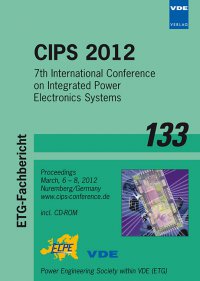Low-pressure (< 5 MPa) Low-temperature Joining of Large-area Chips on Copper Using Nanosilver Paste
Conference: CIPS 2012 - 7th International Conference on Integrated Power Electronics Systems
03/06/2012 - 03/08/2012 at Nuremberg, Germany
Proceedings: CIPS 2012
Pages: 6Language: englishTyp: PDF
Personal VDE Members are entitled to a 10% discount on this title
Authors:
Zheng, Hanguang; Calata, Jesus; Ngo, Khai (Center for Power Electronics Systems, Virginia Tech, Blacksburg, VA 24061, USA)
Zheng, Hanguang; Calata, Jesus; Lu, Guo-Quan (Department of Materials Science and Engineering, Virginia Tech, Blacksburg, VA 24061, USA)
Ngo, Khai; Lu, Guo-Quan (The Bradley Department of Electrical and Computer Engineering, Virginia Tech, Blacksburg, VA 24061, USA)
Luo, Susan (NBE Technologies, LLC, Blacksburg, VA, USA)
Lu, Guo-Quan (Tianjin University, Tianjin, 300072, China)
Abstract:
The low-temperature joining technology (LTJT), either the conventional high-pressure version using micro-size silver powders or the low-pressure version using nanosilver paste, has been widely demonstrated for attaching power chips on silver- or gold-metallized substrates. In this work, we investigated the processing conditions for bonding large-area chips by sintering nanosilver paste directly on plain copper surface. We developed a double-print process for making this type of bonding: started by printing an initial layer of silver paste; followed by drying in pure nitrogen at temperature up to 180 °C; applied a thin second print to ensure complete "wetting" of the paste on the bonding surface of the chip; and then heated in a hot press to 275 °C under pressure ranging from zero to 12 MPa. Ceramic mechanical chips measured at 6 mm x 6 mm were bonded by the double-print process on direct-bond-copper (DBC) substrate. Die-shear test of the attached chips showed an average bonding strength of over 40 MPa at applied pressure of 3 MPa and over 77 MPa under 12 MPa sintering pressure. SEM imaging of the failure surface showed a much denser microstructure of sintered silver layer when applying pressure. X-ray imaging showed a bonding layer free of voids. Since the samples were sintered in air, the DBC surface showed some oxidation. To test the wire-bondability of the oxidized surface, aluminum wires of 250 microns in diameter were wedge-bonded at different locations of the oxidized surface. Pull test results of the bonded wires showed a minimum pull-strength of 400 gram-force, which exceeds the minimum of 100-gf required by the IPC-TM-650 test standard.


